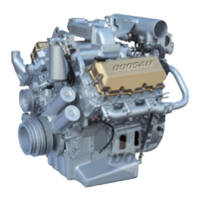DV11
Operation and Maintenance
189
Maintenance of Major Components
Printed in Mar. 2005 PS-MMA0608-E1A
5.3.2. . General information
The engine output depends upon the supplied fuel quantity and the engine efficiency.
In order to transform into the effective work of engine by burning the supplied fuel
fully, the sufficient air to burn the fuel should be supplied to the cylinder. Therefore,
the engine output is essentially determined by the size of the cylinder, and for if the
air is supplied to the given volume of cylinder with the air being compressed, the air
quantity in the cylinder will Increase as much to result in that it may burn more fuel.
the output will also be able to increase, Supplying the air by compressing like this
into the engine cylinder is called as super charging, and super charging by means of
exhaust gas energy that discharges to the atmosphere is called as the turbo
charging.
5.3.3. Function
1) Turbine
The exhaust gas that is discharged from combustion chamber passes through
turbine housing conveying an energy to turbine wings to give the rotating power,
This is called as the turbine and in order not to influence a bad effect at bearing
part, there are the seal ring and heat protector.
2) Compressor
It is connected to the same shaft with the turbine to make a revolving assembly,
and receive the revolving force of turbine, and sends air to the suction manifold
by suctioning and compressing it. This is called as the compressor.
3) Bearing
(1) Thrust bearing
Thrust bearing force is applied to the turbine wheel and an arrangement is
made for the shaft not to shift.
(2) Journal bearing
Journal bearing (floating bearing) is adopted and it forms the double oil films at
the inner and outer surfaces in comparison to the general stationary type so
that the bearing may be able to rotate independently and consequently the
double layers of films act as the damper to make the slipping speed on the
bearing surface less than the rotating speed of shaft so that the dynamic
stability may be obtained.

